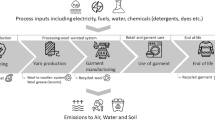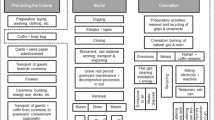Abstract
There is little doubt that covering the façade of a building with a vertical garden can achieve numerous environmental benefits, such as reducing the energy consumption and the overall carbon footprint. However, there remains a need to assess these advantages on a more comprehensive basis. This study investigates the energy use, water use, and greenhouse gas emissions from a vertical garden throughout its life-cycle phases (manufacture, transportation, use, and disposal). This includes a payback period analysis of the energy savings provided by the vertical garden over an assumed lifetime of 20 years. The primary findings of this study were that the use phase has the greatest impact, and that reducing energy and water consumption at this phase has significant impact on the total life-cycle burden. Suggestions were given for future design and evaluation of vertical gardens.






Similar content being viewed by others
References
Alexandri E, Jones P (2008) Temperature decreases in an urban canyon due to green walls and green roofs in diverse climates. Build Environ 43:480–493
Ashby, M (2012). CES EduPack Databases at GrantaDesign.com.
Cheng CY, Cheung KKS, Chu LM (2010) Thermal performance of a vegetated cladding system on facade walls. Build Environ 45:1779–1787
Crawford RH (2011) Life cycle assessment in the built environment. Spon Press, London
Energy Information Administration (EIA) for manufacturing (2010). Retrieved on October 1, 2013, at http://www.eia.gov/consumption/manufacturing/data/2010/
Energy Information Administration (EIA) for residential (2009). Retrieved on October 1, 2013, at http://www.eia.gov/consumption/residential/data/2009/
Eumorfopoulou EA, Kontoleon KJ (2009) Experimental approach to the contribution of plant-covered walls to the thermal behaviour of building envelopes. Build Environ 44:1024–1038
Fang C-F (2007) Evaluating the thermal reduction effect of plant layers on rooftops. Energy Build 40(2008):1048–1052
Hays RL (1975) The thermal conductivity of leaves. Planta 125:281–287
International Stainless Steel Forum (2010). World Stainless Steel LCI. Retrieved April 22, 2012, from http://www.worldstainless.org/
Köhler M (2008) Green facades - a view and some visions. Urban Ecosyst 11:423–436
Kontoleon KJ, Eumorfopoulou EA (2010) The effect of the orientation and proportion of a plant-covered wall layer on the thermal performance of a building zone. Build Environ 45:1287–1303
Kramer, JS (2012). How Products Are Made: Screw. Retrieved April 22, 2012, from http://www.madehow.com/Volume-3/Screw.html
Living Cities (2009). Scaling Up Building Energy Retrofitting in U.S. Cities. Living Cities and Institute for Sustainable Communities.
Lockwood, C (2009). Building Retro. Urban Land. November/December, 46–57.
Matbase (2009). Data Table For: Polymers: Commodity Polymers: HDPE. Retrieved April 22, 2012, from http://www.matbase.com/material/polymers/commodity/hdpe/properties
National Renewable Energy Laboratory (NREL) (2012). U.S. Life-Cycle Inventory Database. Retrieved April 22, 2012, from https://www.lcacommons.gov/nrel/search
Newton J, Gedge D, Early P, Wilson S (2007) Building greener. CIRIA publication, London
Ottelé M, Perini K, Fraaij ALA, Haas EM, Raiteri R (2011) Comparative life cycle analysis for green façades and living wall systems. Energy Build 43:3419–3429
PNNL (Pacific Northwest National Laboratory) (2011). Advanced Energy Retrofit Guides. Energy Efficiency and Renewable Energy, Building Technology Program, U.S. Department of Energy, Contract DE-AC05-76RLO 1830.
Perini K, Ottelé M, Fraaij ALA, Haas EM, Raiteri R (2011) Vertical greening systems and the effect on air flow and temperature on the building envelope. Build Environ 46:2287–2294
Perini K, Ottelé M, Haas EM, Raiteri K (2013) Vertical greening system, a process tree for green façades and living walls. Urban Ecosyst 16:265–277
Phoenix Technologies International LLC (2008). Polyethylene terephthalate Key Properties. Retrieved April 22, 2012, from http://www.phoenixtechnologies.net/why/PET%20Properties%202008.pdf
Shen L (2011) Bio-based and recycled polymers for cleaner production: an assessment of plastics and fibres, Doctoral dissertation. Utrecht University, Netherlands
Spolek G (2008) Performance monitoring of three ecoroofs in Portland, Oregon. Urban Ecosyst 11:349–359
State of California (2012). California Electrical Energy Generation. Retrieved April 22, 2012, from http://energyalmanac.ca.gov/electricity/electricity_generation.html
The Engineering Toolbox (2012). Thermal Conductivity of some common Materials and Gases. Retrieved April 22, 2012, from http://www.engineeringtoolbox.com/thermal-conductivity-d_429.html
The Environmental Integrity Project (2011). Getting Warmer: US CO2 Emissions from Power Plants. Retrieved April 22, 2012, from http://www.environmentalintegrity.org/documents/CO2Report_2011RJD21811final.pdf
The European Chemical Industry Council (2011). Guidelines for Measuring and Managing CO2 Emission from Freight Transport Operations. Retrieved April 22, 2012, from http://www.cefic.org/Documents/IndustrySupport/Transport-and-Logistics/Best%20Practice%20Guidelines%20-%20General%20Guidelines/Cefic-ECTA%20Guidelines%20for%20measuring%20and%20managing%20CO2%20emissions%20from%20transport%20operations%20Final%2030.03.2011.pdf
U.S. Green Building Council (2011). About USGBC. Retrieved April 6, 2012, from http://www.usgbc.org/DisplayPage.aspx?CMSPageID = 124
Wong NH, Tan AYK, Tan PY, Wong NC (2009) Energy simulation of vertical greenery systems. Energy Build 41:1401–1408
Wong NH, Tan AYK, Chen Y, Sekar K, Tan PY, Chan D, Chiang K, Wong NC (2010) Thermal evaluation of vertical greenery systems for building walls. Build Environ 45:663–672
Author information
Authors and Affiliations
Corresponding author
Rights and permissions
About this article
Cite this article
Natarajan, M., Rahimi, M., Sen, S. et al. Living wall systems: evaluating life-cycle energy, water and carbon impacts. Urban Ecosyst 18, 1–11 (2015). https://doi.org/10.1007/s11252-014-0378-8
Published:
Issue Date:
DOI: https://doi.org/10.1007/s11252-014-0378-8




